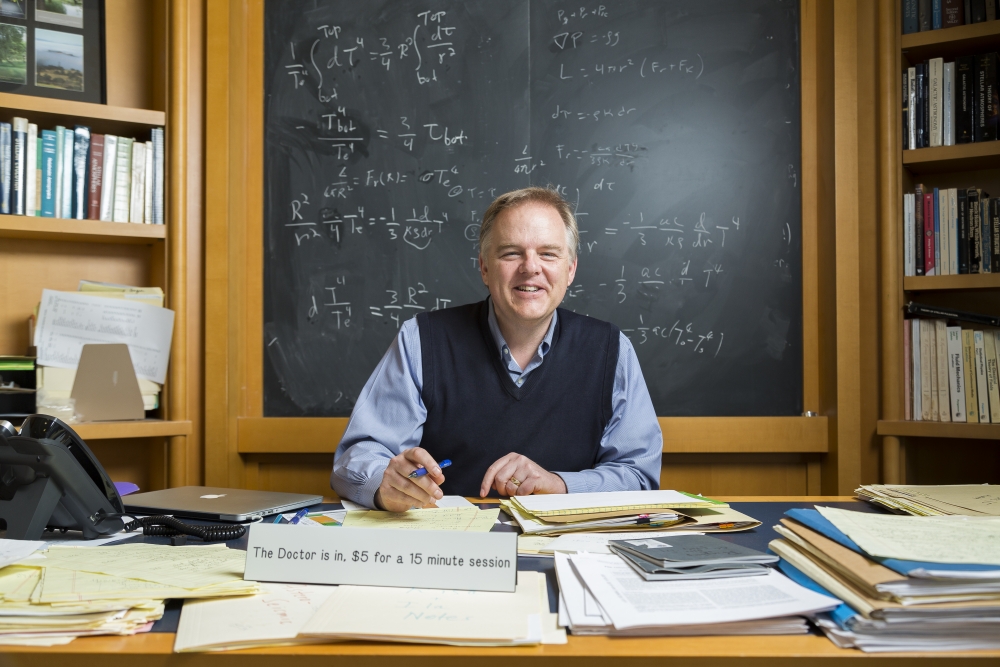
A Stellar Physicist
In what may be classified as an astronomical honor astrophysicist Lars Bildsten, director of UC Santa Barbara’s Kavli Institute for Theoretical Physics (KITP), is among the inaugural class of Fellows of the American Astronomical Society (AAS).
The AAS announced the new accolade to honor members for extraordinary achievement and service. Fellows are recognized for their original research and publication, innovative contributions to astronomical techniques or instrumentation, significant contributions to education and public outreach, and noteworthy service to astronomy and to the society itself.
“It was a very pleasant surprise,” noted Bildsten, who is also the university’s Gluck Professor of Theoretical Physics.
“We congratulate Lars Bildsten on his selection to the inaugural class of fellows of the American Astronomical Society,” said Joe Incandela, the university’s vice chancellor for research. “It is no surprise that he was chosen, given his many scientific accomplishments, as well as his extraordinary leadership and standing in the field.”
Over the course of his career, Bildsten has become a leading member of the astrophysics community. His research focuses on stellar astrophysics, and he is particularly well-known for his work on stellar evolution, pulsations and explosions known as supernovae. Studying the light given off by these phenomena has enabled Bildsten and his collaborators to better understand their properties and the processes that give rise to them.
“I prefer working in those fields of astrophysics where the data are rich and the theories (and theorists) are few,” Bildsten remarked. “That gives me time to think deeply about the problems with my graduate student and postdoc collaborators and not be overly concerned about ‘being scooped.’
“The rapid growth in astronomical surveys has dramatically increased the numbers and types of supernovae we know of”, Bildsten added. “This gave us new opportunities to explain emerging classes of unusual explosions and even predict events that still haven’t been seen.”
Long before he became an eminent astrophysicist, a young Bildsten moved to a suburb of Columbus, Ohio where he enrolled in an alternative high school program. The setting enabled him and his classmates to design their own astrophysics curriculum using the venerable Burnham’s Celestial Handbook as their guide to the universe. The teacher also loaned them the school’s small telescope to use when the Ohio night skies cooperated.
“Nearly all of the students in that class went on to get a Ph.D. in science or engineering,” he said.
Bildsten pursued engineering and physics as an undergraduate at Ohio State University, and enrolled in the physics doctoral program at Cornell University intent on pursuing condensed matter physics.
“But in my first year I took the classic graduate course in stellar structure from Professor Ed Salpeter, a scientific giant in our field,” Bildsten recalled. “That reminded me of my astrophysics passion, and the rest is history.”
Mentored at Cornell by Salpeter and Professor Ira Wasserman, Bildsten’s early work looked at how neutron stars behave as matter accumulates upon them, eventually igniting runaway thermonuclear fusion reactions. The released energy from fusion is not enough to unbind the freshly accreted material; instead the matter simply heats up and radiates for 10 to 100 seconds in what’s called a Type I X-ray Burst. This research was well aligned with two space missions underway at the time: the Rossi X-ray Timing Explorer and the Chandra X-Ray Observatory.
He also conducted early research on neutron star mergers as possible sources of gravitational waves, a phenomenon detected in August 2017 by the LIGO Observatory.
Bildsten would go on to become a prolific stellar researcher. His work put a limit on the spin rate of accreting neutron stars, and he was part of a theoretical collaboration that presented new ideas on the explosive ignition and ejection of thin layers of helium on accreting white dwarfs. His work with UC Berkeley Professor Daniel Kasen also helped link super-luminous supernovae with the birth of rapidly rotating magnetars, or neutron stars with extreme magnetic fields.
Along the way, Bildsten has collaborated with KITP Senior Fellow Bill Paxton and many others to develop the open-source computational instrument, Modules for Experiments in Stellar Astrophysics (or MESA) that is now used by nearly 1,000 scientists around the world.
Now an influential researcher and scientific organizer, Bildsten has served as the director of the KITP since July 2012. In this role, Bildsten works closely with KITP’s faculty, staff and the international physics community to create and host the dozen or so extended research programs that occur each year.
He also serves as a board member and collaborator of the automated Las Cumbres Observatory headquartered in Goleta, and is a member of the board of directors of the Research Corporation for Science Advancement.
Among his numerous honors and awards are the Alfred P. Sloan Foundation Fellowship, the Cottrell Scholar of the Research Corporation, the Helen B. Warner Prize from the American Astronomical Society and the Dannie Heineman Prize for Astrophysics. He was elected to the National Academy of Sciences in 2018.
According to Bildsten, the most rewarding aspect of his work comes from the scientists that he’s interacted with during his career. “I’m most proud of the graduate students, postdoctoral scholars and research collaborators that I have had the pleasure and privilege to work with,” he said. “Science is not done alone.”



